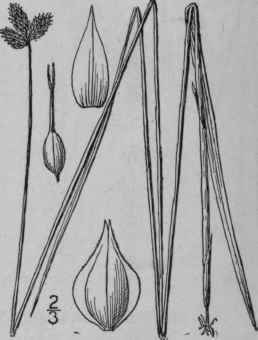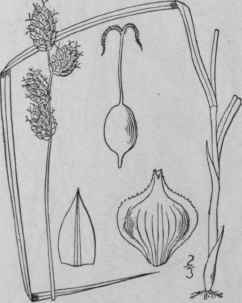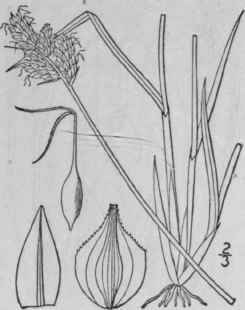18. Carex L. Sp. Pi. 972. 1753.. Part 25
Description
This section is from the book "An Illustrated Flora Of The Northern United States, Canada And The British Possessions Vol1", by Nathaniel Lord Britton, Addison Brown. Also available from Amazon: An Illustrated Flora of the Northern United States, Canada and the British Possessions. 3 Volume Set..
18. Carex L. Sp. Pi. 972. 1753.. Part 25
72. Carex Suberecta (Olney) Britton. Prairie Straw Sedge
Fig. 939
C. foenea var. ferruginea Gray, Man. Ed. 5, 580. 1867.
Not C. ferruginea Scop. C. tenera var. suberecta Olney; Bailey, Proc. Am. Acad.
22: 149 (as synonym). 1889. C. suberecta Britton, Man. Ed. 2, 1057. 1905.
Culms erect, slender, acutely triangular and strongly roughened, 2°-3° high. Leaves 1"-1 1/2" wide, shorter than the culm; lower one or two bracts usually developed, but shorter than the head and inconspicuous; spikes 2-5, silvery greenish or slightly brownish-tinged, short-pointed or rounded, densely many-flowered, ovoid, 3 1/2-7" long, 2 1/2"-4" wide, approximate in a head 7" - 15" long, 4"-7" thick; perigynia erect, strictly appressed, ovate, strongly margined, rounded at base, 2"-2 1/2" long, slightly more than 1" to nearly 1 1/2" wide at base, distended over achene, tapering gradually into a rough 2-toothed beak 1/4-1/3 the length of the nerveless or obscurely nerved body; scales ovate, short-acuminate to obtusish, silvery-green, or in age ferruginous, shorter and rather narrower than the perigynia; stigmas 2.
Moist places, Ontario and Ohio to Michigan, Illinois and Iowa. May-July.


73. Carex Alata Torr. Broad-Winged Sedge
Fig. 940
Carex alata Torr. Ann. Lye. N. Y. 3: 396. 1836.
Culms stiff, rather stout, strictly erect, slightly rough-ish above, 1°-3 1/20 tall. Leaves grass-like, but somewhat rigid, 1"-2" wide, shorter than the culm, sheaths green nearly to chartaceous auricle; spikes suborbicular to oblong-conic, whitish-green or in age brownish-green, very densely many-flowered, 5"-8" long, 3"-$" thick, the lateral rounded or little clavate at base, pointed or obtuse at the summit, all distinct but usually little separated, bractless, or short-bracted; perigynia orbicular or obovate-orbicular, very broadly winged, 2"-2 1/2" long, nearly 1 1/2" or more broad, firm, faintly few-nerved or almost nerveless on inner face, erect and appressed, or somewhat curved upward, the short, abrupt beak about one-third as long as the body: scales lanceolate, acuminate or aristate, scarcely shorter and much narrower than the perigynia; achene distinctly stipitate; stigmas 2.
In moist soil, New Hampshire to Florida, inland to Michigan. May-June.
74. Carex Albolutescens Schwein. Greenish-White Sedge
Fig. 941
Carex albolutescens Schwein. Ann. Lye. N. Y. 1: 66. 1824. Carex stramiiica var. foenea Torr. Ann. Lye. N. V. 3: 395.
1836. Not C. foenea Willd. 1809. Carex albolutescens var. cuniulata Bailey, Bull. Torr. Club 20: 422. 1893.
Similar to the preceding species, but usually lower, culms 1°-2 1/2° tall, stout, strictly erect, slightly rough above. Leaves 1"-2" wide, shorter than the culm; bracts filiform or wanting; spikes 3-8, or sometimes more numerous and somewhat compound, oblong, silvery green when young but becoming light brownish, the lateral rounded or little clavate at base, 3"-6" long, mostly less than 3" thick, clustered, but distinct, the lowest sometimes separated, and very rarely stalked; perigynia broadly ovate, firm, broadly winged, faintly to strongly nerved on both faces, appressed, 11 /2"-2" (rarely 2 1/4") long, 1"-1 1/2" wide, the roughish beak about one-third as long as the body; scales lanceolate, obtuse or acutish, nearly as long as the perigynia, but much narrower; achene nearly or quite sessile; stigmas 2.
In wet soil, along coast, New Brunswick to Venezuela; also about the Great Lakes, on the Pacific coast, and at a few inland stations from Maine to New York. Bermuda. May-July.

Continue to:


